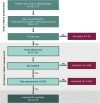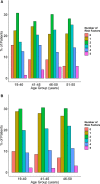Premature Atherosclerotic Cardiovascular Disease: Trends in Incidence, Risk Factors, and Sex-Related Differences, 2000 to 2016
- PMID: 31280642
- PMCID: PMC6662126
- DOI: 10.1161/JAHA.119.012178
Premature Atherosclerotic Cardiovascular Disease: Trends in Incidence, Risk Factors, and Sex-Related Differences, 2000 to 2016
Abstract
Background The incidence of atherosclerotic cardiovascular disease has declined in the past 2 decades. However, these benefits may not extend to young patients. The objective of this work was to assess temporal trends in the incidence, risk profiles, sex-related differences, and outcomes in a contemporary population of young patients presenting with coronary artery disease ( CAD ) in British Columbia, Canada. Methods and Results We used a provincial cardiac registry to identify young patients (men aged <50 years, women aged <55 years), with a first presentation of CAD between 2000 and 2016, who had either ≥50% stenosis of ≥1 coronary arteries on angiography or underwent coronary revascularization. A total of 12 519 patients (30% women) met our inclusion criteria. The incidence of CAD remained stable and was higher for men than women (46-53 versus 18-23 per 100 000). Of patients, 92% had at least one traditional cardiovascular risk factor and 67% had multiple risk factors. The prevalence of diabetes mellitus, obesity, and hypertension increased during the study period and was higher for women. Women had fewer emergent procedures and revascularizations. Mortality rates decreased by 31% between 2000 and 2007, then were stable for the remaining 9 years. Mortality was significantly higher for women aged <45 years compared with men. Conclusions The incidence of premature CAD has not declined, and the prevalence of 3 major cardiovascular risk factors increased between 2000 and 2016. The risk burden and mortality rates were worse for women. These data have important implications for the design of strategies to prevent CAD in young adults.
Keywords: cardiovascular disease; cardiovascular disease risk factors; sex specific; trends; young.
Figures






References
-
- Benjamin EJ, Virani SS, Callaway CW, Chang AR, Cheng S, Chiuve SE, Cushman M, Delling FN, Deo R, de Ferranti SD, Ferguson JF, Fornage M, Gillespie G, Isasi CR, Jiménez MC, Jordan LC, Judd SE, Lackland D, Lichtman JH, Lisabeth L, Liu S, Longenecker CT, Lutsey PL, Matchar DB, Matsushita K, Mussolino ME, Nasir K, O'Flaherty M, Palaniappan LP, Pandey DK, Reeves MJ, Ritchey MD, Rodriguez CJ, Roth GA, Rosamond WD, Sampson UKA, Satou GM, Shah SH, Spartano NL, Tirschwell DL, Tsao CW, Voeks JH, Willey JZ, Wilkins JT, Wu JHY, Alger HM, Wong SS, Muntner P. Heart disease and stroke statistics—2018 update: a report from the American Heart Association. Circulation. 2018;137:e67–e492. - PubMed
-
- Roth GA, Johnson C, Abajobir A, Abd‐Allah F, Abera SF, Abyu G, Ahmed M, Aksut B, Alam T, Alam K, Alla F, Alvis‐Guzman N, Amrock S, Ansari H, Ärnlöv J, Asayesh H, Atey TM, Avila‐Burgos L, Awasthi A, Banerjee A, Barac A, Bärnighausen T, Barregard L, Bedi N, Belay Ketema E, Bennett D, Berhe G, Bhutta Z, Bitew S, Carapetis J, Carrero JJ, Malta DC, Castañeda‐Orjuela CA, Castillo‐Rivas J, Catalá‐López F, Choi JY, Christensen H, Cirillo M, Cooper L, Criqui M, Cundiff D, Damasceno A, Dandona L, Dandona R, Davletov K, Dharmaratne S, Dorairaj P, Dubey M, Ehrenkranz R, El Sayed Zaki M, Faraon EJA, Esteghamati A, Farid T, Farvid M, Feigin V, Ding EL, Fowkes G, Gebrehiwot T, Gillum R, Gold A, Gona P, Gupta R, Habtewold TD, Hafezi‐Nejad N, Hailu T, Hailu GB, Hankey G, Hassen HY, Abate KH, Havmoeller R, Hay SI, Horino M, Hotez PJ, Jacobsen K, James S, Javanbakht M, Jeemon P, John D, Jonas J, Kalkonde Y, Karimkhani C, Kasaeian A, Khader Y, Khan A, Khang YH, Khera S, Khoja AT, Khubchandani J, Kim D, Kolte D, Kosen S, Krohn KJ, Kumar GA, Kwan GF, Lal DK, Larsson A, Linn S, Lopez A, Lotufo PA, El Razek HMA, Malekzadeh R, Mazidi M, Meier T, Meles KG, Mensah G, Meretoja A, Mezgebe H, Miller T, Mirrakhimov E, Mohammed S, Moran AE, Musa KI, Narula J, Neal B, Ngalesoni F, Nguyen G, Obermeyer CM, Owolabi M, Patton G, Pedro J, Qato D, Qorbani M, Rahimi K, Rai RK, Rawaf S, Ribeiro A, Safiri S, Salomon JA, Santos I, Santric Milicevic M, Sartorius B, Schutte A, Sepanlou S, Shaikh MA, Shin MJ, Shishehbor M, Shore H, Silva DAS, Sobngwi E, Stranges S, Swaminathan S, Tabarés‐Seisdedos R, Tadele Atnafu N, Tesfay F, Thakur JS, Thrift A, Topor‐Madry R, Truelsen T, Tyrovolas S, Ukwaja KN, Uthman O, Vasankari T, Vlassov V, Vollset SE, Wakayo T, Watkins D, Weintraub R, Werdecker A, Westerman R, Wiysonge CS, Wolfe C, Workicho A, Xu G, Yano Y, Yip P, Yonemoto N, Younis M, Yu C, Vos T, Naghavi M, Murray C. Global, regional, and national burden of cardiovascular diseases for 10 causes, 1990 to 2015. J Am Coll Cardiol. 2017;70:1–25. - PMC - PubMed
-
- Global status report on noncommunicable diseases 2014. World Health Organization; 2015. http:// www.who.int/nmh/publications/ncd-status-report-2014/en/. Accessed November 26, 2018. - PubMed
-
- Eisen A, Giugliano RP, Braunwald E. Updates on acute coronary syndrome: a review. JAMA Cardiol. 2016;1:718–730. - PubMed
-
- Institute for Health Metrics and Evaluation (IHME) . Epi Visualization. Seattle, WA: IHME, University of Washington; 2017. https://vizhub.healthdata.org/epi/. Accessed August 30, 2018.
Publication types
MeSH terms
LinkOut - more resources
Full Text Sources
Medical
Miscellaneous

